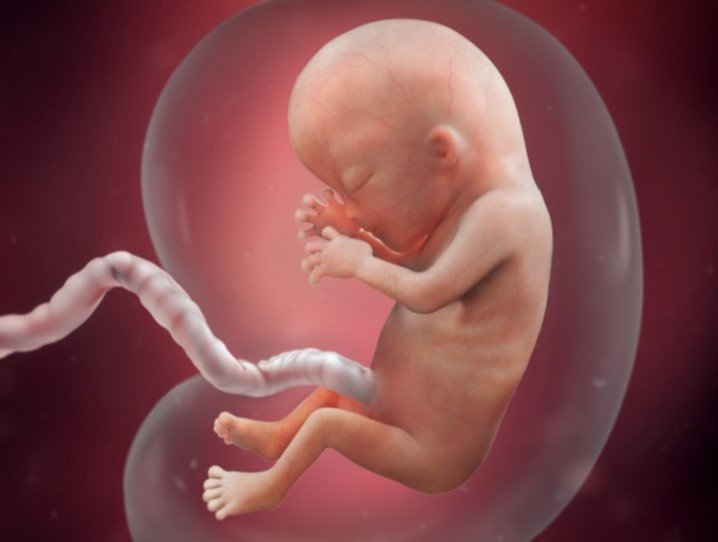Memory Text: “For you created my inmost being; you knit me together in my mother’s womb. I praise you because I am fearfully and wonderfully made; your works are wonderful, I know that full well. My frame was not hidden from you when I was made in the secret place, when I was woven together in the depths of the earth. Your eyes saw my unformed body; all the days ordained for me were written in your book before one of them came to be.” Psalm 139:13-16
Here is one of the more familiar passages in the psalms. “You knit me together in my mother’s womb.” Good that it is highlighted in this week’s lesson; sad that our Adventist Church has sometimes been hesitant to internalize its implications for the crime of abortion.
An unborn child at 13 weeks development in the womb, when it is about the size of a lemon.
At ten weeks, the baby’s skin is still translucent, but their tiny limbs can bend, and fine details like nails are starting to form. At eleven weeks, the baby is almost fully formed. It is kicking, stretching, and even hiccupping as its diaphragm develops. At twelve weeks, the baby's reflexes kick in: its fingers begin to open and close, toes start to curl, and its mouth begins to make sucking movements.
At thirteen weeks, the baby’s tiny fingers have fingerprints, and its veins and organs are clearly visible through their translucent skin. If it is a girl, her ovaries already contain more than 2 million eggs. (At week 20, halfway through the pregnancy, her ovaries will contain 6 to 7 million eggs.)
At 14 weeks, even though the baby is but the size of a lemon, its brain impulses have begun to fire and it is using its facial muscles. Its kidneys are working now, too. At 14 weeks, ultrasound scanning will often show the baby sucking its thumb. (For me, this phase of development lasted until I was about 10 years old.)
We know a great deal about pre-natal gestation and development. The idea that a baby in the womb at, say, 13 weeks is just a “cluster of cells” is absurd. It is a baby. We know that now by “science”; David knew it by inspiration. Civilized jurisdictions do not allow abortion beyond the first trimester, because the criminal nature of such an act is beyond obvious.
But what are we to make of the contrast between, “you knit me together in my mother’s womb” (v. 13) and “I was woven together in the depths of the earth” (v. 15)? Which is it?
When David is speaking of himself, it is his mother’s womb. When he refers to the depths of the earth, I believe David is referring to the creation of mankind, because Scripture is very clear that God created mankind from the dirt of the earth. (Gen. 2:7; 3:19; Job 4:19; 33:6; Isa. 64:8; 1 Cor. 15:47; 2 Cor. 4:7)
Mankind being “woven together in the depths of the earth” is poetic language getting at the idea that we cannot penetrate to the exact way God created mankind; it remains a mystery, just as if it had been done “in the depths of the earth.” That act of special creation is even more mysterious to us than the exact way that a baby was “knit together in a mother womb” was mysterious to the people in David’s day. Some things belong to God alone.
The passage also hints at continuity between God’s creation of Adam and Eve, and every procreation of a baby in its mother’s womb. The latter is dependent upon the former. Were it not for God’s creation of Adam and Even with the ability to procreate, we would not exist. So every baby in the womb can rightly be viewed as a creative miracle that points us back to our Creator in Eden.
Now that we know more about the stuff of life, especially the genetic language encoded into the DNA molecule, we can appreciate the continuity between creation and procreation even more. We all share Adam’s DNA, through Noah. That genetic coding has changed and evolved over the millennia, but we are all related; that remains the bottom line. If only that were what the Darwinists meant by “common descent” they would be correct. Sadly, when Darwinists use the term “common descent” they are expressing their belief that apes and humans share a simian ancestor, that also evolved from other mammals, and so on back across the ages to the “primordial swamp.”
But the existence of DNA refutes the larger claims of Darwinism. DNA contains a code, and no code—not written language, not Morse Code, not musical notation, not computer code—ever wrote itself spontaneously. Encoding information is always the act of a creative intelligence trying communicating information. There are no exceptions to that rule. The existence of DNA proves that we are intelligently designed.
Yes we are created, fearfully and wonderfully created by God (Gen. 1:27) through our Lord Jesus Christ (John 1:3; Heb. 1:2), who created our first parents with the ability to procreate, so that He knit each one of us together in our mother’s womb.



